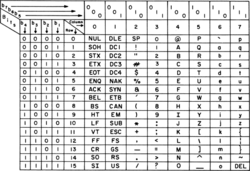
Back ASCII ALS أسكي Arabic ASCII AST ASCII Azerbaijani اسکی AZB ASCII Byelorussian ASCII Bulgarian অ্যাস্কি Bengali/Bangla ASCII BS ASCII Catalan
 ASCII chart from MIL-STD-188-100 (1972) | |
| MIME / IANA | us-ascii |
|---|---|
| Alias(es) | ISO-IR-006,[1] ANSI_X3.4-1968, ANSI_X3.4-1986, ISO_646.irv:1991, ISO646-US, us, IBM367, cp367[2] |
| Language(s) | English (made for; does not support all loanwords), Malay, Rotokas, Interlingua, Ido, and X-SAMPA |
| Classification | ISO/IEC 646 series |
| Extensions |
|
| Preceded by | ITA 2, FIELDATA |
| Succeeded by | ISO/IEC 8859, ISO/IEC 10646 (Unicode) |
ASCII (/ˈæskiː/ ASS-kee),[3]: 6 an acronym for American Standard Code for Information Interchange, is a character encoding standard for electronic communication. ASCII codes represent text in computers, telecommunications equipment, and other devices. ASCII has just 128 code points, of which only 95 are printable characters, which severely limited its scope. The set of available punctuation had significant impact on the syntax of computer languages and text markup. ASCII hugely influenced the design of character sets used by modern computers, including Unicode which has over a million code points, but the first 128 of these are the same as ASCII.
The Internet Assigned Numbers Authority (IANA) prefers the name US-ASCII for this character encoding.[2]
ASCII is one of the IEEE milestones.[4]
- ^ ANSI (1975-12-01). ISO-IR-6: ASCII Graphic character set (PDF). ITSCJ/IPSJ.
- ^ a b "Character Sets". Internet Assigned Numbers Authority (IANA). 2007-05-14. Retrieved 2019-08-25.
- ^ Mackenzie, Charles E. (1980). Coded Character Sets, History and Development (PDF). The Systems Programming Series (1 ed.). Addison-Wesley Publishing Company, Inc. pp. 6, 66, 211, 215, 217, 220, 223, 228, 236–238, 243–245, 247–253, 423, 425–428, 435–439. ISBN 978-0-201-14460-4. LCCN 77-90165. Archived (PDF) from the original on May 26, 2016. Retrieved August 25, 2019.
- ^ "Milestone-Proposal:ASCII MIlestone - IEEE NJ Coast Section". IEEE Milestones Wiki. 2016-03-29. Retrieved 2024-02-26.
© MMXXIII Rich X Search. We shall prevail. All rights reserved. Rich X Search